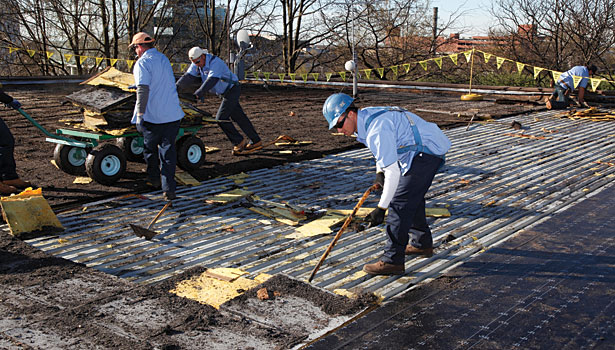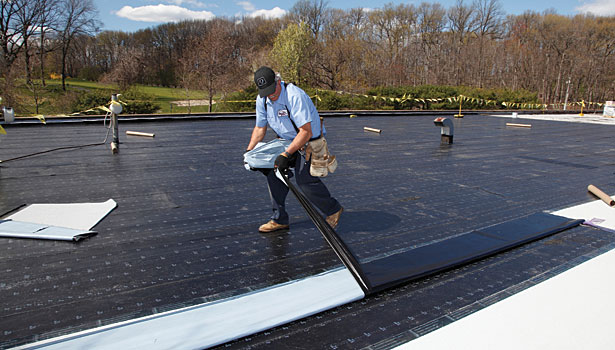03 Apr
You Can Bank On It
Roof Pro Inc. Relies on Proven System for Complex Re-Roofing Project
By Chris King
April 03, 2014
Scott Summers is president of Roof Pro Inc., headquartered in Bay Shore, N.Y. The company does commercial work on Long Island and throughout the five boroughs of New York, as well as some high-end residential work. Roof Pro handles a lot of work for management companies, realty holding companies, large shopping centers and institutions such as banks. They had completed service, repair and roof replacement projects for multiple branches of Astoria Federal Savings Bank, so when the company had a tricky problem with the roof on its corporate headquarters in Long Island, Roof Pro answered the call.
“The roof was literally floating like a water bed,” Summers recalled.
The existing roof was really two roof systems, with the original hot-tar built-up roof underneath a layer of insulation and a loose-laid, ballasted EPDM membrane. “The perimeter had failed, the drains had failed, and the water had gotten under the EPDM and was running to the drains,” he said. “There must have been four or five inches of water between the roofs, but the built-up roof was not leaking that badly.”
Roof Pro came up with a plan to repair the leaks, tear off the old roof systems and install a new roof. They were invited to bid on the project and won the bid, but keeping the building watertight and open for business throughout the project was a tall order. “Obviously this was a highly sensitive building for them,” said Summers. “This was where all of the executive offices are, as well as the management team. Banks are always highly sensitive, but this was highly, highly sensitive. Security–wise and operations-wise, this was a dicey one.”
Summers maintains that Roof Pro is not your typical, mainstream roofing company. “I think most of the companies out there are clones of each other,” he said. “We’ve always taken a production mentality and worked backwards from it — not a sales mentality. We look at roofs as engineers; we don’t look at roofs like salesmen.”
This perspective sets them apart from the competition, according to Summers. “The difference is we’re going to look at the roof the way it needs to be built, give you the options, let you choose,” he said. “We help customers educate themselves about the best options and let them make their own decision from a point of intelligence. We’re going to specify the job properly. And once the job is sold, we live with that number.”
Taking it to the Bank
For the Astoria Bank corporate headquarters project, Roof Pro worked with bank management to design the new roof system, which featured a self-adhered SBS modified bitumen system from Polyglass®. The roof system would consist of two plies of Elastoflex® SA V base sheet and a white, self-adhered cap sheet, Elastoflex SA P. The system specified was already working well on several of the bank’s branches.
Summers likes this system because it’s durable, good-looking, and easy to install, but he noted other important benefits, including the fact that there are no solvents or torches used in the installation process. Summers said he is conducting a “one-man crusade” against the use of any open flame on the rooftop. “We do not own torches,” he said. “We won’t use them. It’s taboo. In fact in New York City it’s illegal to use them in the five boroughs on a wooden structure.”
Self-adhered systems do have some temperature constraints, though, and when the decision was made to go ahead on the corporate headquarters, it was December. The low temperatures precluded the installation of a self-adhered membrane, which typically isn’t installed at temperatures below 40 degrees Fahrenheit. “In this region, we generally stop using that product around Halloween and pick it up again around St. Patrick’s Day,” noted Summers. “Sometimes you can install it a little later or start it a little earlier, but essentially that’s your working window in the Northeast region.”
Roof Pro came up with an interim plan to get them through the winter months. “What we ended up doing was removing the ballast stone and the EPDM systems and exposing the original roof in December,” he said. “The problem we had was if it started failing in the middle of winter, there would have been no way to service this roof with the EPDM layer in place. The water would be frozen between the layers.”
Roof Pro patched areas of the old roof to get it through the winter and began work in early March, which was unseasonably warm. “We were staged and as soon as the weather opened up for us we were ready to go,” Summers said. “They were first on line. We didn’t want to let it sit too long. It was an old, tired roof, and it was over their corporate headquarters. It couldn’t have been over a worse possible place.”
After the old roof was removed, installers then mechanically fastened a double layer of polyiso insulation to the steel decking. A 2-inch layer and a 1.5-inch layer were offset to eliminate thermal bridging. The next step was installing the two-ply self-adhered Polyglass base sheet (Elastoflex SA V) and a self-adhered cap sheet with white granules (Elastoflex SA P). “We essentially built the roof in two-ply, then came back and installed the cap and final flashing,” said Summers.
The primary challenge was maintaining a watertight environment while removing the old roof and installing the new one. “Now we’re cutting up and segmenting into the building and as you can imagine, this is one of my most important clients, and this is the last place on earth we’d like to have any type of incident,” he said.
To make things even more complicated, the building was in use the entire time the project was under way. Noise was a concern, and at times the project was halted for meetings and some corporate events. “The building was fully functional,” noted Summers. “I was working around their world, that’s for sure.”
The cooling towers on the building were replaced at the same time as the roof, so they had to ensure no dust entered the fresh-air intakes during the tear-off. Fumes were not a problem during the installation of the field membrane, noted Summers, because the self-adhered product had no fumes and very low VOCs. “There were no flash-off or solvent issues, which was important for an occupied building,” he said. “This product is good for schools and other places that have the air conditioning running. There is no solvent smell going in the building.”
The roof was divided into four sections, and work began in the furthest quadrant. “We worked backwards to the pitch with the rip, meaning we worked from the top down and left an underlap so that we could work backwards to the drains. The insulation made the new roof higher than the old roof, so we had to make sure our binders weren’t blocking the flow of water.”
Chris King is editor of Roofing Contractor.
For the complete article on NY Roof Maintenance in West Islip, Suffolk County, New York, check out Roofing Contractor.
Roof Pro Inc, your local New York Roofing Company serves the entire Dix Hills, Suffolk County, Babylon, Nassau County, & Long Island surrounding areas!





Sorry, the comment form is closed at this time.